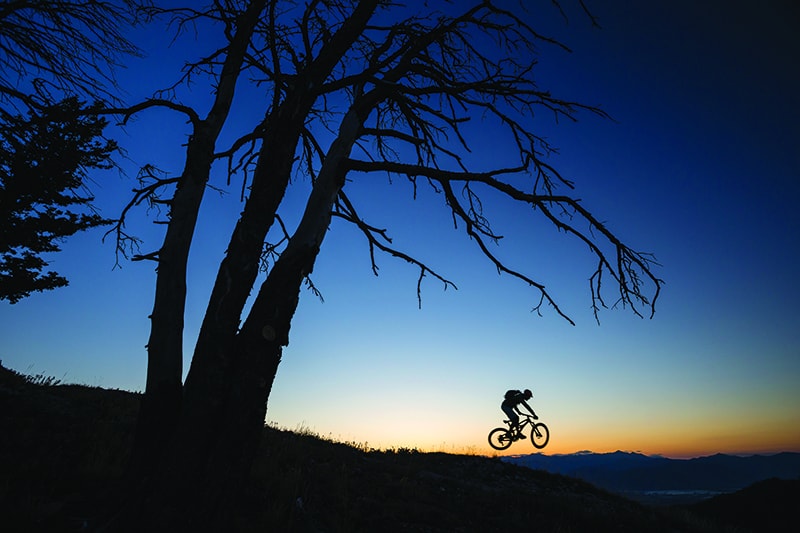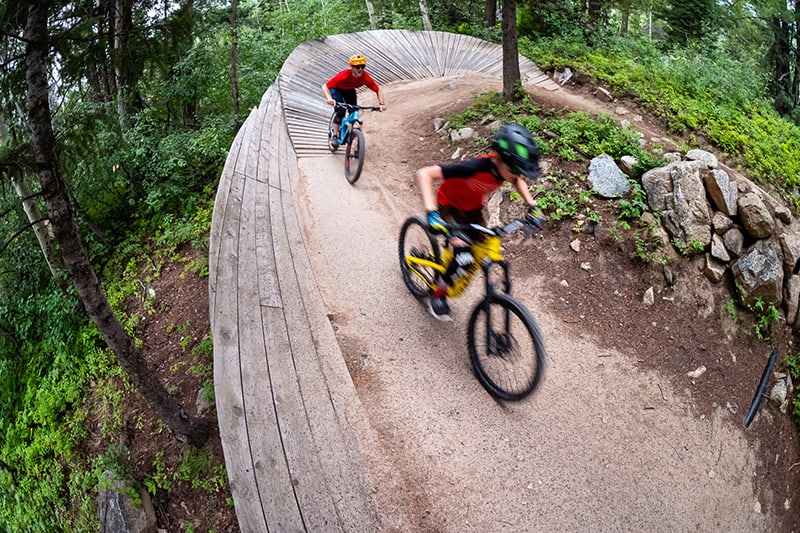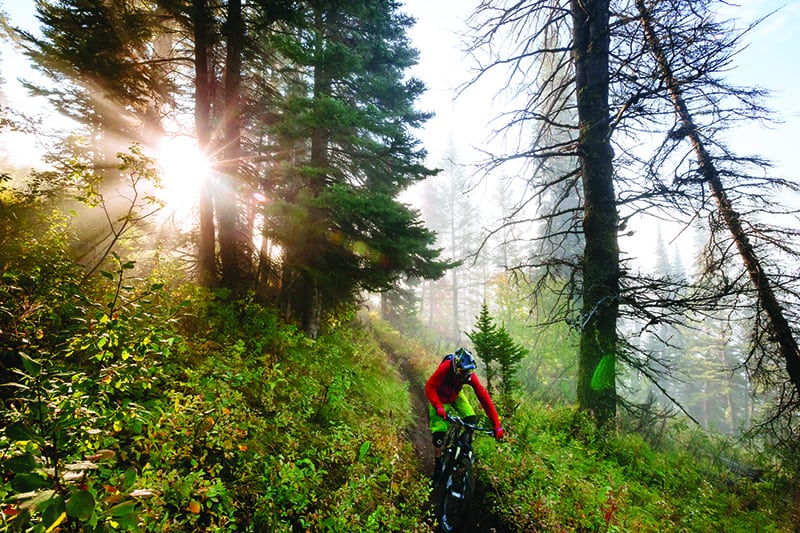Read The
Current Issue
All Downhill
Try gravity riding to have a chairlift or car get you and your mountain bike to the top. Then, enjoy the down.
By Cy Whitling

Andrew Whiteford descends the Lithium trail on Teton pass. Photo by Jay Goodrich
At the parking lot on the top of Teton Pass, we buckle our helmets and double check to make sure someone’s got the keys to the car we just parked at the bottom. Then we’re off, pedaling along the ridge to Mt. Elly, working our way through the dense fields of wildflowers at the top of the pass.
Ever since bikes have existed, people have been riding them downhill. There’s something addictive about rolling into a descent, letting the wheels spin as you coast to the bottom. That’s how mountain biking was invented after all, hippies hauling garage-modified road bikes up rugged dirt roads, then racing each other to the bottom. Gravity, or downhill, mountain biking is just the natural extension of that. All it takes is a bike with knobby tires, a helmet, and a trail that is set up to let a shuttle car or a chairlift do the work of hauling you back up the hill. And the Tetons are rife with great downhill riding.
At the end of the ridge we stop to adjust the heights of our saddles, tighten our knee pads, and wipe down goggles. Last night it rained for the first time in weeks, and the trail known as Lithium should still be moist and tacky, which mountain bikers call “hero dirt” because the great traction it provides makes riding feel effortless.
We drop in through waist-deep wildflowers just as the sun pops above the Gros Ventre Mountains on the east side of the valley. Our bikes dance along the six-inch-wide trail; it’s almost buried in blossoms. A rider ahead of me whoops hoarsely as we exit a meadow and drop into the first steep section. The dirt is as hero as we hoped it would be—just loose enough to let you slide the bike through rutted corners yet grippy and consistent.
We descend the trail’s different sections, stopping to take turns riding the rock spine, “sessioning” it, as we dial in our lines. A few more loamy, bermed corners, a big compression, and we’re back at the bottom of Teton Pass, where we parked a van only an hour earlier. The elderly gentleman walking his dog doesn’t understand why we’re all giggling uncontrollably as we load our bikes into the van for another drive to the top.
The Tetons are home to some of the best, most diverse gravity riding in the Mountain West. Downhill mountain biking needs a specific set of factors to really thrive. Obviously you need mountains with the vertical relief to be worth descending, and some sort of road or chairlift to get you back to the top; beyond that, local sentiment and culture play a huge part. Land managers like those at the United States Forest Service (USFS) are often skeptical of allowing downhill-specific bike trails to be built, and it can be hard to convince ski resorts to run their chairlifts for mountain bikers in the summer.
Luckily, in the Tetons, the stars have aligned on all counts. Passionate riders had been building downhill trails on Teton Pass for years, but in 2004 the Teton Freedom Riders were officially formed to build and maintain legal downhill trails. The group partners with the Bridger Teton National Forest (BTNF) to develop and maintain one of the few public gravity riding areas in a national forest anywhere in the country.
Along with the riding on the pass, both Jackson Hole Mountain Resort (JHMR) and Grand Targhee Resort have embraced mountain biking, building trails and running chairlifts all summer to cater to gravity riders. As downhill riding has grown in the Tetons, it’s also become more accessible. There are beginner-friendly trails at both bike parks, and even on Teton Pass. Both Targhee and JHMR offer bike and gear rentals, along with lessons.
Jackson Hole Mountain Resort Bike Park

Jackson Hole Mountain Resort’s Bronco trail is a popular intermediate trail. It doesn’t have any steep or technical sections, but does have banked corners and great flow. Photo by Jay Goodrich
JHMR offers the easiest-to-access and most family-friendly gravity/downhill mountain biking experience in the Tetons. Its Teewinot chairlift serves a handful of trails at varying levels, which are graded similarly to ski trails: green = easy, blue = intermediate, and black = expert. Laps are short and fast—Teewinot only climbs about 300 vertical feet—so it’s easy to get to know every trail on the mountain at your skill level, and find a favorite. Intermediate bikers often love Bronco, a mellow blue. It’s smooth and winding, and there are no steep or technical sections that ruin the flow. There aren’t any real jumps, but there are rollers and berms galore. Every corner is bermed, and every berm is just a little bit different; they’re slow and low at the top, and gradually get steeper and faster. A Bronco challenge for experienced downhillers: Try to “pump”—maintain speed without pedaling—your way down.
If Bronco is the ultimate intermediate/warmup trail, Bandit is the trail you want to ride four times in a row, sessioning until you have every jump locked down. Like Bronco it’s smooth and flowy. Unlike Bronco it is packed with a huge variety of jumps. All jumps are tabletops, none have mandatory gaps, and they get progressively bigger as you descend. Riders who don’t want to catch air can roll over all of them and keep both wheels on the dirt. For riders who do want some wind under their tires, Bandit is the best JHMR trail for that. Open 10 a.m. to 6 p.m. daily (conditions permitting) from mid-June into September. Lift tickets $37 for all ages. Fridays mid-June through mid-August between 5 p.m. and 7 p.m. “Friday Night Bikes” feature $10 lift tickets and half-price bike rentals. jacksonhole.com, 307/733-2292
Teton Pass

Andrew Whiteford riding the downhill-only Parallel Trail on Teton Pass. It has gap jumps and other man-made features, but for those who like to keep their wheels on the ground, most of these can be ridden around. Photo by Jay Goodrich
Teton Pass is home to the highest concentration of and, arguably, the best gravity biking trails in Jackson Hole. People travel to Jackson Hole from elsewhere in the country just to ride the Pass. Originally—15 to 20 years ago—the only trails were illegal, scratched in by riders willing to risk the ire of the USFS. (The east side of Teton Pass is in the BTNF.) Now though, thanks to a partnership among Teton Freedom Riders, Friends of Pathways, and the BTNF, the gravity trails on the pass are legal, and well-constructed. Trails are also shuttle-friendly.
Like all of the trails on the north side of the pass, Phillips Canyon requires a short uphill pedal to start, with about four and a half miles of rolling trail to the top. Once you’ve done this, the trail is one of the best descents in the valley. All-out singletrack sections mix with steeper, technical zones, although there are no big, challenging features. You’ll end about four miles up Fish Creek Road from downtown Wilson. Note that Phillips is not a directional-specific trail: there likely will be some uphill riders, who have the right-of-way over downhillers. If you feel like earning your turns, the ride up Phillips is about 3 miles and 1,700 vertical feet of climbing.
The south side of Teton Pass is home to the valley’s most difficult and technical downhill trails. Of these, Blacks Canyon is the least challenging, but still not a cakewalk. The top section offers great views of the Snake River and Jackson Hole and the numerous mountain ranges that ring the valley. Also on offer are steep, loose, and exposed corners. Once you drop into the woods the trail has lots of fun, rocky features, but no big jumps or drops. Near the creekbed about two-thirds of the way down, it becomes tight singletrack lined with mossy trees and high ferns—it’s like flying through a greenish blur.
Lithium is one of the steepest, most technical, and most challenging descents in the area. Because it is one of the original downhill trails, dating to a time when riding was less about flow and berms, it highlights steeps and stunts. Make sure your brakes are working well when you drop in. A beautiful meadow quickly leads into steep forest; then there’s an awkward move onto a rocky ridge, more steeps, more rocky ridge, and a lower section that channels the Pacific Northwest with ferns, rock rolls, and loamy chunder. A few big jumps and drops round it out.
Jimmy’s Mom, a classic Teton flow trail, starts at the parking lot about two-thirds of the way up the east side of Teton Pass and drops down to Old Pass Road (decommissioned for cars, but maintained for bikes, walkers, and rollerskiers) just above Crater Lake. “Teton flow” means it’s primarily jumps, drops, and berms, and a few technical sections. Most features require mandatory jumps over gaps. We recommend getting familiar with the trail before you huck your meat. If you don’t like your wheels leaving the ground, don’t ride this trail. Wondering who Jimmy’s mom is? Legend has it that she was the Teton Freedom Riders’ original volunteer accountant. The first feature on the trail, a big step-up jump onto a rock with a drop-off, is named the “stepmom.” The riding season on Teton Pass varies annually based on the melting winter snowpack. All trails here are free; Teton Freedom Riders runs shuttles on Saturdays through the summer that are free with a suggested donation. Tetonfreedomriders.org, 307/739-5414
Grand Targhee Park

Collin Wheeler rides the Rock Garden Trail, one of the most challenging trails at Grand Targhee Resort. Photo by Cy Whitling
Grand Targhee offers a bigger bike park experience than JHMR, with two chairlifts, a vertical drop of more than 2,000 feet (if you take the lift to the top of Fred’s Mountain), and a wider diversity of trails, including steep technical ones, mellow rollers, and huge jump lines. A warning: If you ride from the top of Fred’s Mountain (via the Dreamcatcher lift), the tech trails, especially Rock Garden, are chunky and challenging. Blondie is the newest of these. It’s a classic downhill trail—hand-built and then ridden in—with plenty of big stumps and complicated off-camber line choices. There aren’t any jumps or traditional bike park features; instead, nature does the work.
Bring it on Home starts at the top of the Shoshone lift (where Blondie ends), and is Blondie’s polar opposite in every way. It’s smooth, flat, and flowy, and the easiest gravity trail on either side of the Tetons. It’s also one of the most fun, as it serves up abundant berms and small rollers. This is the trail for young kids, or that friend who hasn’t been on a bike in ages. More experienced riders shouldn’t write it off though—like JHMR’s Bronco, it’s a good challenge to pump it just right so you barely have to pedal, and plenty of the rollers turn into potential jumps with adequate speed. Open 10 a.m. to 5 p.m. daily mid-June into September (conditions permitting). $41 for adults; kids under 12, $31. “Family Fridays” run from 4 p.m. to 7 p.m. on the last Friday of every month and feature $10 lift tickets. grandtarghee.com, 800/TARGHEE. JH




